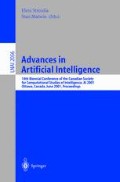Abstract
Our computer reasoning system uses a set of memory networks, a spatial simulator and an object-oriented hierarchy of body-based spatial metaphors to reason about abstract concepts. The metaphor hierarchy is based on the hierarchical nature of embodied actions, and the simulator is designed to model these actions. The system maps its input to a set of spatial metaphors at the most detailed level possible, and then uses modeling of the metaphorical concepts to reason about the original input.
Access this chapter
Tax calculation will be finalised at checkout
Purchases are for personal use only
Preview
Unable to display preview. Download preview PDF.
References
Bailey, D.: A Computational Model of Embodiment in the Acquisition of Action verbs. Ph.D. dissertation, Computer Science Division, EECS Dept., University of California at Berkeley. Berkeley, CA. (1997)
Berkowitz, E. G.: Metaphor-Based Reasoning for Software Agents and Heterogeneous Robots Using Body-Based Feeling Sequences. Ph. D. dissertation, Illinois Institute of Technology, Chicago IL. (2000)
Berkowitz, E. G. and Greene, P. H.: Using a Feeling Based Lexicon to Integrate Language and Reasoning. Preceedings of KBCS 2000. Mumbai, India. (2000) 355–364
Brooks, R.: Elephants Don’t Play Chess. Robotics and Autonomous Systems. 6(1990) 3–15
Damasio, A. R.: The Feeling of What Happens: Body and Emotion in the Making of Consciousness. New York: Harcourt Brace. (1999)
Greene, P. H.: Introduction to I. M. Gelfand, (Ed.-in-Chief), with V. S. Gurfinkel, S. V. Fomin, and M. I. Tsetlin (Assoc. Eds.). Models of the Structural-Functional Organization of Certain Biological Systems, (Translated by C. R. Beard). Cambridge, MA: MIT Press. (1971)
Greene, P. H.: Problems of Organizaton of Motor Systems. In R. Rosen and F. M. Snell (Eds.), Progress In Theoretical Biology. 2 New York: Academic Press. (1972)
Greene, P. H.: Why Is It Easy to Control Your Arms? Journal of Motor Behavior. 14 (1982) 260–286.
Greene, P. H.: Cognitive Structures in Movement: Cahiers de Psychologie Cognitive. 7 (1987) 163–166
Greene, P. H.: The Organization of Natural Movement. Journal of Motor Behavior. 20 (1988) 180–185.
Greene, P. H. and Chien, G. H.: Feeling-Based Schemas, Neural Architectures, and Distributed AI: From Schema Assemblage to Neural Networks. Proceedings of the 1993 Workshop On Neural Architecture and AI. Univ. of Southern California, Los Angeles, CA. (1993) 112–115
Greene P. H. and Solomon D.: A Computer System for Movement Schemas. In Badler, N. I., Barsky, B. A., and Zeltzer, D., Making It Move: Mechanics and Animation of Articulated Figures. Palo Alto, CA: Morgan Kaufmann. (1991) 193–205
Johnson, M.: The Body in the Mind: The Bodily Basis of Meaning, Imagination, and Reason. Chicago: University of Chicago Press. (1987)
Kozak, M. M.: Body-Based Cognition: Reasoning Guided by Feeling, Emotion, and Metaphor. Ph. D. Dissertation, Illinois Institute of Technology, Chicago, IL. (1994)
Kozak, M. M.: Reasoning Based on Feelings and Metaphor, Sixth Midwest Artificial Intelligence and Cognitive Science Conference, Carbondale, IL. (1995) 132–137
Lakoff, G.: Women, Fire, and Dangerous Things. University of Chicago Press. Chicago, IL.(1987)
Langacker R. W.: Foundations of Cognitive Grammar, Vol. I, Stanford, CA.: Stanford Univ. Press. (1987)
Langacker R. W.: Foundations of Cognitive Grammar, Vol. II, Stanford, CA.: Stanford Univ. Press. (1991)
Narayanan S.: Knowledge-Based Action Representation For Metaphor and Aspect. Dissertation in Engineering and Compuer Science, University of California at Berkeley. Berkeley, CA. (1997)
Pinker, S.: Learnability and Cognition. Cambridge, MA: MIT Press. (1989)
Riesbeck, C. and Schank, R.: Inside Case Based Reasoning. NY, NY: Lawrence Elbaum Associates. (1989)
Solomon, D.: An Object-Oriented Representation for Motor Schemas. Ph. D. Dissertation, Illinois Institute of Technology. Chicago, IL. (1989)
Talmy, L.: Force Dynamics in Language and Thought. In Papers from the Parasession on Causatives and Agentivity. Chicago, Chicago Linguistic Society (1985)
Author information
Authors and Affiliations
Editor information
Editors and Affiliations
Rights and permissions
Copyright information
© 2001 Springer-Verlag Berlin Heidelberg
About this paper
Cite this paper
Berkowitz, E.G., Greene, P.H. (2001). Body-Based Reasoning Using a Feeling-Based Lexicon, Mental Imagery, and an Object-Oriented Metaphor Hierarchy. In: Stroulia, E., Matwin, S. (eds) Advances in Artificial Intelligence. Canadian AI 2001. Lecture Notes in Computer Science(), vol 2056. Springer, Berlin, Heidelberg. https://doi.org/10.1007/3-540-45153-6_5
Download citation
DOI: https://doi.org/10.1007/3-540-45153-6_5
Published:
Publisher Name: Springer, Berlin, Heidelberg
Print ISBN: 978-3-540-42144-3
Online ISBN: 978-3-540-45153-2
eBook Packages: Springer Book Archive

